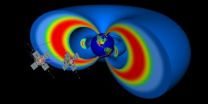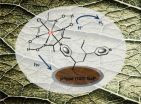(Press-News.org) In end-stage lung disease, transplantation is sometimes the only viable therapeutic option, but organ availability is limited and rejection presents an additional challenge. Innovative research efforts in the field of tissue regeneration, including pioneering discoveries by University of Vermont (UVM) Professor of Medicine Daniel Weiss, M.D., Ph.D., and colleagues, holds promise for this population, which includes an estimated 12.7 million people with chronic obstructive pulmonary disorder (COPD), the third leading cause of death in the U.S.
In the past year alone, Weiss and colleagues published four articles in Biomaterials, the leading bioengineering journal, as well as two March 2014 articles by first author Darcy Wagner, Ph.D., a postdoctoral fellow working in Weiss' lab, reporting their development of new methods and techniques for engineering lungs for patients with COPD and pulmonary fibrosis.
Weiss and his team's work focuses on lung tissue bioengineering, which involves the use of a scaffold – or framework – of lungs from human cadavers to engineer new lungs for patients with end-stage disease. Their studies have examined multiple perspectives on the process of stripping the cellular material from these lungs – called decellularizing – and replacing it with stem cells (recellularization), in an effort to grow new, healthy lungs for transplantation.
Working in animal and human models, Wagner, Weiss and colleagues have addressed numerous challenges faced during the lung tissue bioengineering process, such as the storage and sterilization of decellularized cadaveric scaffolds and the impact of the age and disease state of donor lungs on these processes.
In one of the latest Biomaterials studies, "Three-dimensional scaffolds of acellular human and porcine lungs for high throughput studies of lung disease and regeneration," the researchers report on novel techniques that increase the ability to perform high-throughput studies of human lungs.
"It's expensive and difficult to repopulate an entire human lung at one time, and, unlike in mouse models, this doesn't readily allow the study of multiple conditions, such as cell types, growth factors, and environmental influences like mechanical stretch – normal breathing motions – that will all affect successful lung recellularization," explains Weiss.
To address this, Wagner developed a technique to dissect out and recellularize multiple, small segments in a biological/physiological manner that would take into consideration the appropriate three-dimensional interaction of blood vessels with the lung's airways and air sacs.
Working with biomaterials scientist Rachel Oldinski, Ph.D., UVM assistant professor of engineering, they further developed a new method using a nontoxic, natural polymer derived from seaweed to use as a coating for each lung segment prior to recellularization. This process allowed the team to selectively inject new stem cells into the small decellularized lung segments while preserving vascular and airway channels. Use of this technique, which resulted in a higher retention of human stem cells in both porcine (pig) and human scaffolds, allows the small lung segments to be ventilated for use in the study of stretch effects on stem cell differentiation.
"The ability to perform numerous experiments and screen multiple conditions from a single decellularized human lung provides an avenue to accelerate progress towards the eventual goal of regenerating functional lung tissue for transplantation," says Wagner.
Through another novel technique – thermography or thermal imaging – Wagner and colleagues developed a non-invasive and non-destructive means for monitoring the lung scaffolds' integrity and physiologic attributes in real-time during the decellularization process. According to Wagner, this method could be used as a first step in evaluating whether the lungs and eventual scaffolds are suitable for recellularization and transplantation.
The development of these new techniques are "a significant step forward" in the field of lung regeneration, say Wagner and her coauthors.
This study and Weiss' and Wagner's related publications over the past 15 months showcase the positive impact of the $4.26 million National Institutes of Health (NIH) Director's Opportunity for Research grant Weiss received in October 2010 as part of the American Recovery and Reinvestment Act funding. In addition to these scientific accomplishments, he's forged strong industry ties, as well, and has several patents pending.
"This work serves as a core for helping develop a robust bioengineering effort to parallel ongoing stem cell activities in the Department of Medicine and for fostering increasing collaborative efforts between the Colleges of Medicine and Engineering," says Weiss.
INFORMATION: END
Research on 3D scaffolds sets new bar in lung regeneration
2014-03-07
ELSE PRESS RELEASES FROM THIS DATE:
New NASA Van Allen Probes observations helping to improve space weather models
2014-03-07
Using data from NASA's Van Allen Probes, researchers have tested and improved a model to help forecast what's happening in the radiation environment of near-Earth space -- a place seething with fast-moving particles and a space weather system that varies in response to incoming energy and particles from the sun.
When events in the two giant doughnuts of radiation around Earth – called the Van Allen radiation belts -- cause the belts to swell and electrons to accelerate to 99 percent the speed of light, nearby satellites can feel the effects. Scientists ultimately want ...
NASA satellites see double tropical trouble for Queensland, Australia
2014-03-07
There are two developing areas of tropical low pressure that lie east and west of Queensland, Australia. System 96P and System 98P, respectively. The MODIS instrument that flies aboard both NASA's Aqua and Terra satellites captured images of both tropical trouble-makers as each satellite passed overhead on March 7.
In the Coral Sea, part of the Southwestern Pacific Ocean, System 96P was just 125 nautical miles/143.8 miles/231.5 km north-northeast of Willis Island, Australia. It was centered near 14.3 south latitude and 150.6 east longitude. System 96P is moving in south-southwesterly ...
The dark side of fair play
2014-03-07
We often think of playing fair as an altruistic behavior. We're sacrificing our own potential gain to give others what they deserve. What could be more selfless than that? But new research from Northeastern University assistant professor of philosophy Rory Smead suggests another, darker origin behind the kindly act of fairness.
Smead studies spite. It's a conundrum that evolutionary biologists and behavioral philosophers have been mulling over for decades, and it's still relatively unclear why the seemingly pointless behavior sticks around. Technically ...
Service is key to winery sales
2014-03-07
ITHACA, N.Y. – To buy, or not to buy? That is the question for the more than 5 million annual visitors to New York's wineries. Cornell University researchers found that customer service is the most important factor in boosting tasting room sales, but sensory descriptions of what flavors consumers might detect were a turn-off.
The findings stem from two studies on how the tasting room experience affects customer purchases and what wineries can do to create satisfied sippers, published in the current issue of the International Journal of Wine Business Research.
"On average, ...
Ever-so-slight delay improves decision-making accuracy
2014-03-07
NEW YORK, NY (March 7, 2014) — Columbia University Medical Center (CUMC) researchers have found that decision-making accuracy can be improved by postponing the onset of a decision by a mere fraction of a second. The results could further our understanding of neuropsychiatric conditions characterized by abnormalities in cognitive function and lead to new training strategies to improve decision-making in high-stake environments. The study was published in the March 5 online issue of the journal PLoS One.
"Decision making isn't always easy, and sometimes we make errors ...
Notre Dame chemists discover new class of antibiotics
2014-03-07
A team of University of Notre Dame researchers led by Mayland Chang and Shahriar Mobashery have discovered a new class of antibiotics to fight bacteria such as methicillin-resistant Staphylococcus aureus (MRSA) and other drug-resistant bacteria that threaten public health. Their research is published in the Journal of the American Chemical Society in an article titled "Discovery of a New Class of Non-beta-lactam Inhibitors of Penicillin-Binding Proteins with Gram-Positive Antibacterial Activity."
The new class, called oxadiazoles, was discovered in silico (by computer) ...
New theory on cause of endometriosis
2014-03-07
Changes to two previously unstudied genes are the centerpiece of a new theory regarding the cause and development of endometriosis, a chronic and painful disease affecting 1 in 10 women.
The discovery by Northwestern Medicine scientists suggests epigenetic modification, a process that enhances or disrupts how DNA is read, is an integral component of the disease and its progression. Matthew Dyson, research assistant professor of obstetrics and gynecology at Northwestern University Feinberg School of Medicine and and Serdar Bulun, MD, chair of obstetrics and gynecology ...
Bone turnover markers predict prostate cancer outcomes
2014-03-07
(SACRAMENTO, Calif.) —Biomarkers for bone formation and resorption predict outcomes for men with castration-resistant prostate cancer, a team of researchers from UC Davis and their collaborators have found. Their study, published online in the Journal of the National Cancer Institute, also found that the markers identified a small group of patients who responded to the investigational drug atrasentan. The markers' predictive ability could help clinicians match treatments with individual patients, track their effectiveness and affect clinical trial design.
Castration-resistant ...
Promising news for solar fuels from Berkeley Lab researchers at JCAP
2014-03-07
There's promising news from the front on efforts to produce fuels through artificial photosynthesis. A new study by Berkeley Lab researchers at the Joint Center for Artificial Photosynthesis (JCAP) shows that nearly 90-percent of the electrons generated by a hybrid material designed to store solar energy in hydrogen are being stored in the target hydrogen molecules.
Gary Moore, a chemist and principal investigator with Berkeley Lab's Physical Biosciences Division, led an efficiency analysis study of a unique photocathode material he and his research group have developed ...
Anti-psychotic medications offer new hope in the battle against glioblastoma
2014-03-07
Researchers at the University of California, San Diego School of Medicine have discovered that FDA-approved anti-psychotic drugs possess tumor-killing activity against the most aggressive form of primary brain cancer, glioblastoma. The finding was published in this week's online edition of Oncotarget.
The team of scientists, led by principal investigator, Clark C. Chen, MD, PhD, vice-chairman, UC San Diego, School of Medicine, division of neurosurgery, used a technology platform called shRNA to test how each gene in the human genome contributed to glioblastoma growth. ...



